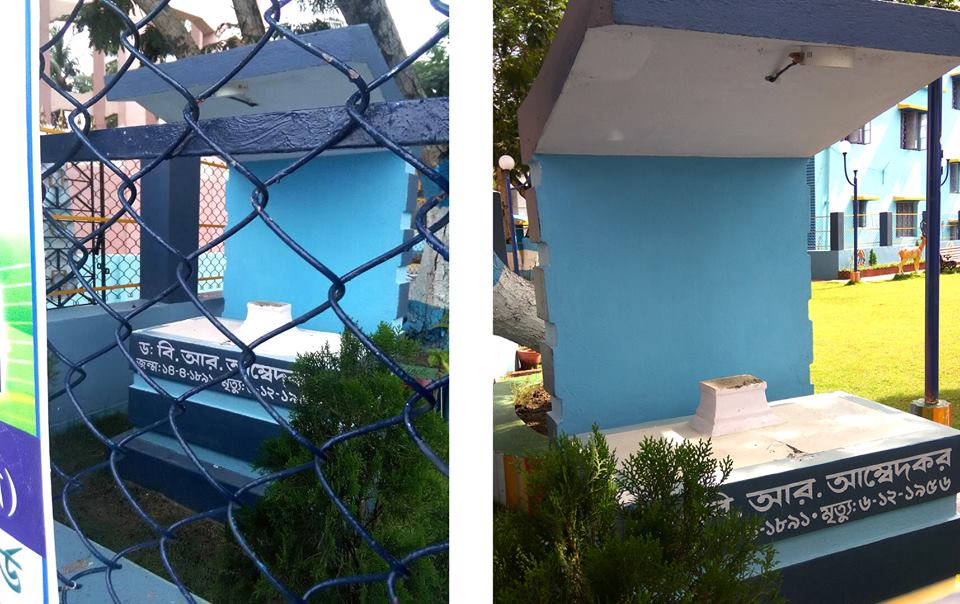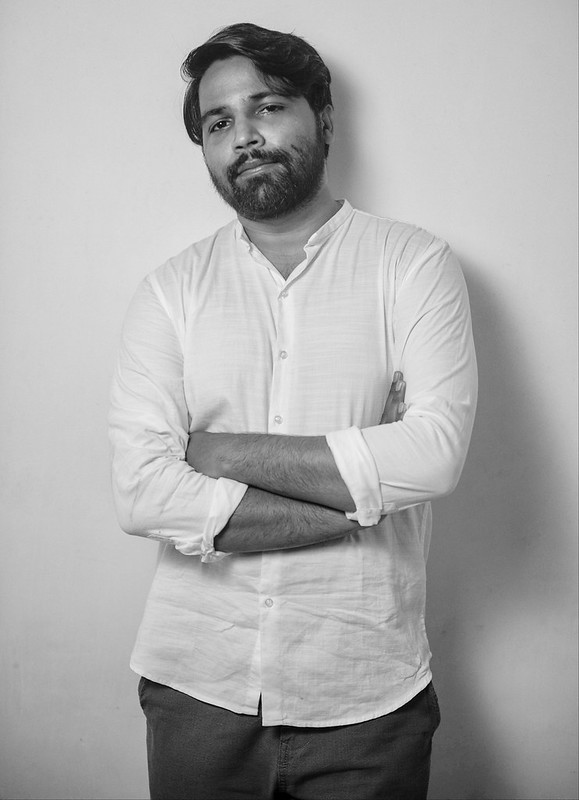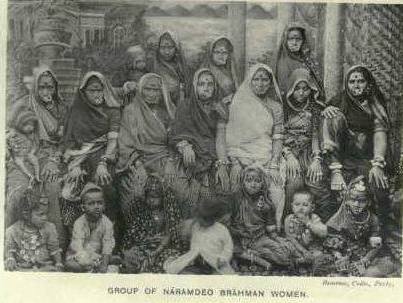Pinak Banik
On the midnight of 29th May, a marble bust of Babasaheb Ambedkar was found disfigured. This statue was installed 17 years ago inside the Dr. B. R. Ambedkar Sishu Uddyan (Children’s park) at Shayamaprasad Nagar, Nimta, North Dumdum, Ward num. 9. The bust was found by joggers the next morning in the sewer drain beside the park. 15 days have passed since then and no administrative intervention has yet been conducted in this regard. A FIR was filed on 4th June and till date, there is neither any information provided by the police regarding the perpetrators behind this act of casteist infraction nor any clarification of the details of the atrocious affair. Ambedkarite individuals and organizations are agitating in various places around the region since the very day of the incident. Some Bahujan journalists have already reported this on few Bangla dailies, web portals and outrage is spreading on social media.

Bhadrolok Politics of Denial and Dispense: Story of a ‘Park’
Around the end of the 1970s and beginning of 80s, few young Dalit Bahujans, steeped in Ambedkarite consciousness, formed a group in North DumDum locality. By 1982 these young Ambedkarites, Samir Roy, Kalipada Sarkar, Priyanath Kirtaniya, Rishikesh Mistry and others had founded Uttar Dumdum SC ST OBC Welfare Organization and started working among the Bahujans of their locality, spreading Ambedkarite consciousness and helping them with resolving pressing material issues through constitutional means. They also started building a fund to install a statue of Babasaheb in the future. North Dumdum and the adjacent localities are largely inhabited by the Dalit Bahujans (approximately 70-80% bahujan and 60% of them Dalits), mostly refugees, who migrated after partition or the 1971 Liberation war. Though uprooted and scattered by partition, this Dalit Bahujan population carried rich memories of anti-caste legacies from iconic leaders like Harichand Thakur, Guruchand Thakur, Jogendranath Mandal, Rashiklal Sarkar etc. The entire stretch from Bongaon, Machhlandapur, Barasat, Palta, Durganagar, Dumdum and beyond has a very similar population pattern and the influx of refugees still continues in these localities.

These assertive movements by young enlightened Ambedkarites in a small neighborhood of Dumdum were also largely associated with the acquaintance of Saheb Kanshiram and emergence of Bahujan movement in the 70s. Saheb Kanshiram had formed BAMCEF by then. Few Dalit Bahujans who were able to establish themselves in modern professions gained some material means, took part in BAMCEF activities in Bengal. This initiated a close relationship between Saheb Kanshiram and the emerging consciousness of Ambedkarites of Bengal, mostly based in the above-mentioned localities. Saheb Kanshiram made frequent visits to Bengal during this phase, which continued till he became virtually immobile due to his health. Ranendralal Biswas first invited Kanshiram in 1981 and on 30th and 31st August of the same year. The first BAMCEF Convention was held in Kolkata’s College Square Student’s Hall. Bimal Krishna Biswas, who used to host Kanshiram at his house in Kolkata, was an employee with the Airports Authorities of India and a member of BAMCEF. Even before forming Bahujan Samaj Party Kanshiram made plans of forming a political party office in Mantu Golder’s house in New Barrakpur. Later DS-4 was formed in 1981 and almost every corner of Bengal provided a well-organized army of dedicated Ambedkarites to both DS-4 and BAMCEF. After forming Bahujan Samaj Party in 1984 in Delhi, Kanshiram asked his close associate Mahendranath Talukdar to organize the West Bengal wing of BSP. ‘Bahujan Nayak’ became the Bangla mouthpiece of the West Bengal BSP wing from September 1984. On 5th February 1989, a massive rally was organized at the Shahid Minar in Kolkata with Kanshiram as the key speaker. On 15th September, the same year another rally was held at the same venue in Kanshiram’s presence. Bahujan Samaj Party developed organizational agility and started posing a challenge to the ruling parties of Bengal. The predetermined refugee vote bank, as well as the larger Bahujan vote bank of CPIM was under threat by the autonomous Bahujan political emergence. In 1992 and 94, Kanshiram held two more rallies in Kolkata, respectively at Shahid Minar and Brigade.

There were many assertive movements led by young enlightened Ambedkarites in the small neighborhood of North Dumdum in the early 80s in this context. Uttar Dumdum SC ST OBC Welfare Organization led by young Ambedkarites demanded the then CPIM led municipality to allot them a space for Ambedkarite political activism.
Since allotment of a space for political activism may not have been possible, they demanded the allotment of land for a park in Dr. Ambedkar’s name, as there was already a well-maintained children’s park in Chacha Nehru’s name in the Shayamaprasad Nagar locality. Their intention was to have a space for the children of the community as well as a center for their political activism. After almost a year long struggle and under the shadow of emerging Bahujan Movement, the municipality finally approved a khas land beside the Chacha Nehru Children’s Park and registered it under the name of Ambedkar Uddyan in 1885. But within a short time of the allotment of the land, it was made a public park, it was fenced and locked and no further activity was possible inside the park.
Eventually, the park was transformed into a storehouse of the discarded pipelines and construction material of the Municipality. Bushes grew all over the land and grass became taller than humans around the park. Later a large water tank came to be installed within the premises of the park. For years the park remained closed and occupied. The adjacent Chacha Nehru Park never had to undergo such a fate in the Communist regime.

Those young Ambedkarites who had already collected funds to build Babasaheb’s statue found the park no more habitable to host the statue and they installed the statue near another playground in the same locality.
Around this time, Ambedkarites had launched campaigns to revive the Ambedkar Uddyan and make it available to the public. They led deputations to the Municipality office and after making tremendous efforts, the municipality decided to clear the park of the wilderness. But again it remained closed most of the time. By 1997-98 the CPIM led municipality planned to set up a Health Center inside the park, taking away almost half of its land, which finally closed all possibilities of the space being a hub for political gathering. It even became unsuitable as a playground for the children.
Ambedkarite groups had marked available land in another part of the locality where the Health Center could have been built and proposed this to the Municipality, asking them to spare the Ambedkar Uddyan from infringement. By then several other Ambedkarite groups had been formed and they led agitations around this issue. But the plan of Health Center within the Park premises, despite available lands in other parts of the locality, was never discarded. On April 10th, 2000, Ashim Dasgupta, the then Finance Minister of WB Govt inaugurated the Health Centre amidst the agitation of Ambedkarites.
Under the continual outrage from Ambedkarites groups, the municipality came up with a solution to resolve the issue and tame the anger among the Dalit Bahujans. They proposed installation of a statue of Dr. Ambedkar within the remaining part of the park! Within that same year, a half bust marble statue of Dr. Ambedkar was installed just beside the front gate, inside the park. Such interesting politics of denial and dispense! Since then Ambedkar Uddyan has remained either locked or unused or seldom used by children. Ambedkarites could hardly use the park to run their programs. In February 2017, the park was remodeled, gentrified and renamed as Dr. B. R. Ambedkar Children’s Park by the present Trinamool Congress-led Municipality.
On the morning of 28th May, the statue of Dr. Ambedkar was found broken and half-submerged in a sewer drain beside the park, displaced from the foundation and pedestal. Some Ambedkarites reached the place and with the help of the locals and police, the statue was rescued and kept inside the Health Center. The statue has remained there since then. The local Councilor was informed and North Dumdum City Trinamool Congress had promised to rebuild the statue at its place. North Dumdum City Trinamool Congress (Ward num 9) has immediately placed a banner hiding the view of the vandalized pedestal, which says, “We condemn the vile conspiracy of CPIM and BJP of demolishing the statue of Dr. B. R. Ambedkar. – Courtesy: Basanti Dey Biswas (Councilor, North Dumdum Municipality.)”
But even after 15 days after the incident, no perpetrator has been arrested or even been investigated. The police have given no explanation yet or revealed any details of the incident to Ambedkarite organizations and individuals, who have visited the Nimta Police Station several times in the last week. It seems the administration is more interested in reinstalling the statue rather than finding the culprits who had dared to vandalize and throw the statue in the sewer.
Dalit Bahujans are demanding a probe into this criminal act, instead of another patronized installation of a statue. As Ambedkarite activist Atul Howladar remarked, “Ambedkar statues are gradually becoming a toy in the hands of the ruling parties to play with.” The Bangla word Dushkriti (miscreants) has been continuously used by the police to refer to the perpetrators, but no attempt has been made yet to identify the real culprits behind these Dushkritis.

The teashop adjacent to the park is usually open until 11 pm and the shopkeeper hadn’t seen anything suspicious till then on that night of the incident. People are usually on the streets till 11.30-12 pm. Then this must have taken place after that, around midnight. After a visit to the park, we found the entire park to be fenced with al least 8 feet high wall and wire fences. The park also has a newly built iron gate at the entrance with a height of around 10 feet. The broken part of the marble statue weighs nearly a quintal. Though encroaching the park can be possible but taking the heavy statue out of the park over the fence, even by few men seems impossible. This possibly can’t happen without a free exit route either through the main entrance or exit of the park. Even if the statue was taken over the wall and wire fences, there is no trace or mark of any collision or scratch neither on them nor on the walls of the sewer, which again seems unmanageable, given the weight of the marble statue is around a quintal. Although this matter is up to proper police investigation, all these suggest that this act might have happened with an accurate plan, ample manpower and possible access to the entrance or exit of the park, which is usually locked during those hours.
Response of Dalit Bahujan Organizations:
“While civil society and intellectuals were busy debating the removal of Lady Justice statue in Bangladesh, Babasaheb’s statue was vandalised in Kolkata. Why are they so indifferent, maintaining derisive silence when a statue of Dr Ambedkar has been attacked? This is never-ending prejudice of casteist forces under the mask of intellectualism… They have attacked our self-respect. We have given a deadline to the administration. The perpetrators have to be arrested and Babasaheb’s statue has to be reinstalled with due respect. Otherwise, Dalit Bahujans of Bengal will act reminding them that they had sent Babasaheb to the Constituent Assembly from this Land.” said Saradindu Biswas, of Dalit Bahujan Self-Determination Movement.
On June 4th, a meeting was called by Anagrasar Jana Jagarani Mancha (a collective of Ambedkarite Organizations) and The Friend’s Mission, Birati to discuss this issue and further actions at the Friend’s Mission. The meeting was attended by several Ambedkarite leaders, activists, writers like Sucheta Golder, Chapala Ray Majumdar, Manju Bala, Smritikana Howladar, Sukriti Ranjan Biswas, Saradindu Biswas, Syed Ahmed, Bankim Biswas, Nakul Mallik, Nitish Biswas, Nirmal Bala, Atul Howladar, Debasish Golder, Apurba Biswas, Prashanta Ray, Bijan Hazra etc. Ambedkarite activist from Assam, Suniel Bhaumaraj was also present. Chapala Ray Majumdar reminded everyone of the vandalization of another Ambedkar statue in Ghola, near Sodepur in 1998 and the course of the events that followed. At the end of the meeting, a demonstration was led to the Nimta Police Station (Ambedkar Children’s Park is under the jurisdiction of this police station). A FIR was lodged and the police promised the activists that they would take necessary steps towards the investigation. Police have requested for 3 days time to provide some details but this hasn’t been done till date. Several rallies and public meetings have already happened in Hridaypur, New Barrakpur, Durganagar, Dumdum, Nimta, Alipur, Birati etc., and are still happening.
Ambedkarite individuals and organizations have been waiting for the investigation reports while simultaneously expressing their outrage and informing people of their demands. They are also preparing to go for larger movements if the administration maintains this negligent approach towards the issue.
~
Sources:
Ranajit Kumar Sikdar; ‘Muktidoot Kanshiram o Bahujan Samaj Party’
Personal meetings and informal discussions with Apurba Biswas, Debasish Golder, Sucheta Golder, Saradindu Biswas, Chiranjit Das, Atul Howladar, Smritikana Howladar and others have helped in the gathering the history of Ambedkar Park.
Images Courtesy: Pinak Banik, Chiranjit Das.
~~~
Pinak Banik is a visual artist and independent researcher from West Bengal. His areas of interest are Socio-cultural Historiography, Political economy, Anthropology, Art, and Society.









